本机环境
Win 8 JDK 7 Maven 3.2 Nexus 2.11版本选择
http://www.sonatype.org/nexus/archivednexus 2.6 及 2.6+ 版本要求 jdk 1.7 或 1.7+ 版本(jdk 1.6 请选择 nexus 2.5 及 以下版本)。根据你现有的环境来选择合适的版本。
这里选择 nexus-2.11.0 (如果无法打开下载, 可将新标签页地址栏中的地址复制到迅雷等下载工具中进行下载)。
下载得到 nexus-2.11.0-bundle.zip 压缩包。解压缩里面的 nexus-2.11.0-02 目录,如我的 E:\setup\dev\servers\nexus, 最终得到
的目录结构为 E:\setup\dev\servers\nexus\nexus-2.11.0-02。
配置 nexus 环境
NEXUS_HOME = E:\setup\dev\servers\nexus\nexus-2.11.0-02Path = .;%NEXUS_HOME%\bin
安装 nexus 服务
如果你所使用的是 Win8 操作系统,以下操作需要管理员权限。在命令行中执行 nexus install(Win8 系统组合键为 Ctrl + X, A):C:\WINDOWS\system32>nexus install
wrapper | nexus installed.
wrapper | nexus installed.
启动 nexus
在命令行中执行 nexus start:C:\WINDOWS\system32>nexus start
wrapper | Starting the nexus service...
wrapper | Waiting to start...
wrapper | Waiting to start...
wrapper | Waiting to start...
wrapper | nexus started.
页面访问的入口地址:http://localhost:8081/nexuswrapper | Starting the nexus service...
wrapper | Waiting to start...
wrapper | Waiting to start...
wrapper | Waiting to start...
wrapper | nexus started.
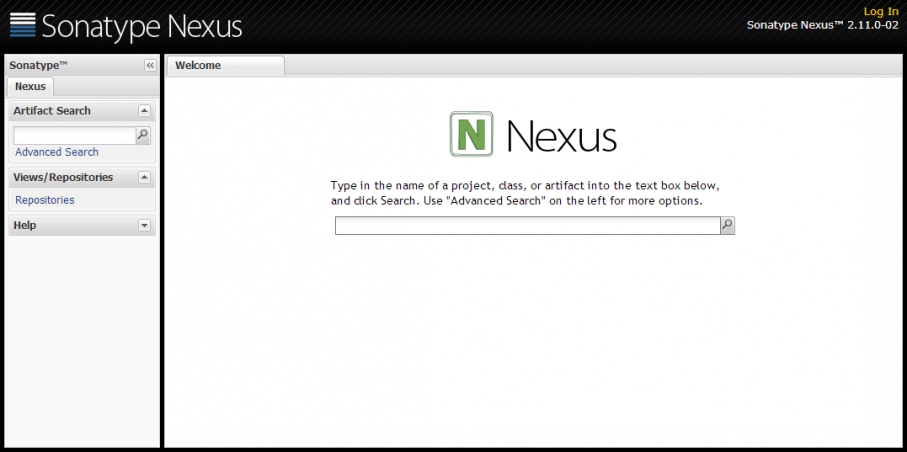
登录 nexus
默认的管理员账号是:admin, 密码是:admin123停止 nexus
在命令行中执行 nexus stop:C:\Users\fanlychie>nexus stop
wrapper | Stopping the nexus service...
wrapper | Waiting to stop...
wrapper | nexus stopped.
wrapper | Stopping the nexus service...
wrapper | Waiting to stop...
wrapper | nexus stopped.
修改 nexus 账号密码
先停止 nexus,打开 %NEXUS_HOME%\sonatype-work\nexus\conf\security.xml,修改即可。
nexus 的密码采用 SHA1 加密算法 ( 在线加密工具 ),将加密后的 SHA1 串(小写)拷贝覆盖原来的。重启 nexus:nexus restart 。
nexus 的密码采用 SHA1 加密算法 ( 在线加密工具 ),将加密后的 SHA1 串(小写)拷贝覆盖原来的。重启 nexus:nexus restart 。
<user>
<id>admin</id>
<firstName>Administrator</firstName>
<lastName>User</lastName>
<password>2899441143e28aee7287e8da3d7211258f5edbd3</password>
<status>active</status>
<email>fanlychie@yeah.net</email>
</user>
<id>admin</id>
<firstName>Administrator</firstName>
<lastName>User</lastName>
<password>2899441143e28aee7287e8da3d7211258f5edbd3</password>
<status>active</status>
<email>fanlychie@yeah.net</email>
</user>
修改 nexus 端口
打开 %NEXUS_HOME%\nexus-2.11.0-02\conf\nexus.properties, 修改 application-port 的值。重启 nexus:nexus restart 。application-port=8081
application-host=0.0.0.0
nexus-webapp=${bundleBasedir}/nexus
nexus-webapp-context-path=/nexus
application-host=0.0.0.0
nexus-webapp=${bundleBasedir}/nexus
nexus-webapp-context-path=/nexus
仓库类型
打开 Views/Repositories --> Repositories 视图
nexus 仓库分为 4 种,group(仓库组)、hosted(宿主仓库)、proxy(代理仓库)、virtual(虚拟仓库)。
我们自己开发的构件通常是发布到 hosted 仓库,proxy 用来代理远程的公共仓库,一个 group 可以包含多个 hosted/proxy 仓库。
仓库组
打开 Views/Repositories --> Repositories --> Public Repositories --> Configuration 视图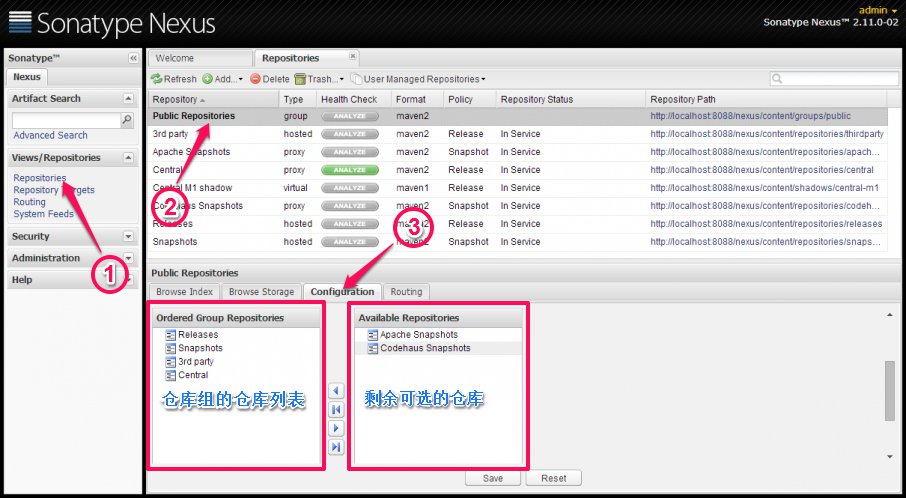
Configuration 栏的左边是仓库组仓库列表,右边是当前可选的仓库,可以从右边挑选合适的仓库加入到左边的仓库组,点击 Save 保存即可。
一个仓库组通常包含了多个仓库,仓库组中的仓库列表的顺序决定了构件下载时遍历的仓库的先后次序,因此,建议将远程中央仓库(Central)放
到仓库组的最后一项。
maven settings.xml 配置
在 settings.xml 配置文件中添加如下配置:<servers>
<server>
<id>releases</id>
<username>admin</username>
<password>admin123</password>
</server>
<server>
<id>snapshots</id>
<username>admin</username>
<password>admin123</password>
</server>
<server>
<id>thirdparty</id>
<username>admin</username>
<password>admin123</password>
</server>
</servers>
<mirrors>
<mirror>
<id>nexus</id>
<mirrorOf>*</mirrorOf>
<name>nexus public repositories</name>
<url>http://127.0.0.1:8088/nexus/content/groups/public</url>
</mirror>
</mirrors>
<server>
<id>releases</id>
<username>admin</username>
<password>admin123</password>
</server>
<server>
<id>snapshots</id>
<username>admin</username>
<password>admin123</password>
</server>
<server>
<id>thirdparty</id>
<username>admin</username>
<password>admin123</password>
</server>
</servers>
<mirrors>
<mirror>
<id>nexus</id>
<mirrorOf>*</mirrorOf>
<name>nexus public repositories</name>
<url>http://127.0.0.1:8088/nexus/content/groups/public</url>
</mirror>
</mirrors>
<server> 节点配置服务的账户密码,用于发布构件时进行身份和权限的认证。<mirror> 节点用于镜像的配置,具体用法参考 maven 镜像配置
发布构件
在 nexus 中找到如下的视图页面: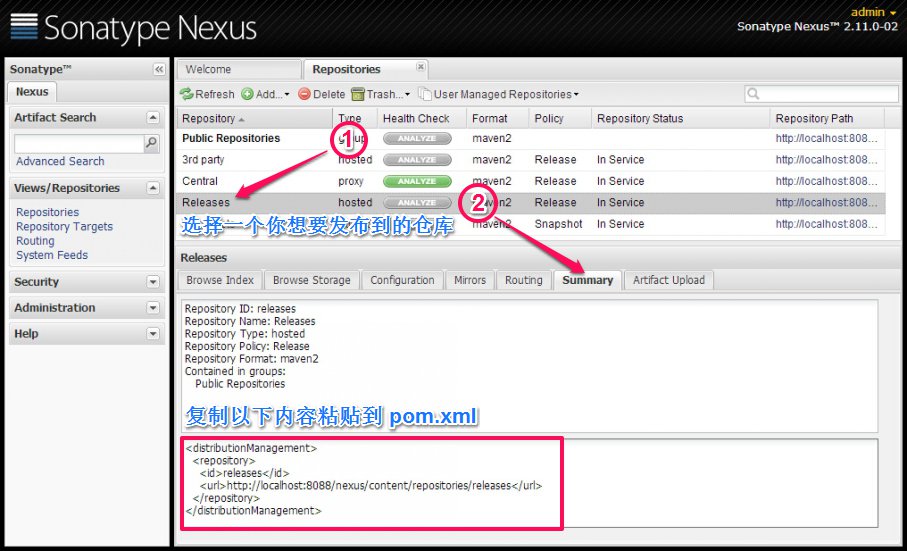
复制以上的配置,粘贴到你的 pom.xml 配置文件中:
<project xmlns="http://maven.apache.org/POM/4.0.0" xmlns:xsi="http://www.w3.org/2001/XMLSchema-instance"
xsi:schemaLocation="http://maven.apache.org/POM/4.0.0 http://maven.apache.org/xsd/maven-4.0.0.xsd">
<modelVersion>4.0.0</modelVersion>
<groupId>org.fanlychie</groupId>
<artifactId>proj</artifactId>
<version>1.0.0</version>
<packaging>jar</packaging>
<name>proj</name>
<url>http://maven.apache.org</url>
<distributionManagement>
<repository>
<id>releases</id>
<url>http://localhost:8088/nexus/content/repositories/releases</url>
</repository>
</distributionManagement>
</project>
这里需要注意的是,repository 节点的 id 需与 settings.xml 中配置的 server 节点的 id 相同,如果不相同,修改任意一方都可以,只xsi:schemaLocation="http://maven.apache.org/POM/4.0.0 http://maven.apache.org/xsd/maven-4.0.0.xsd">
<modelVersion>4.0.0</modelVersion>
<groupId>org.fanlychie</groupId>
<artifactId>proj</artifactId>
<version>1.0.0</version>
<packaging>jar</packaging>
<name>proj</name>
<url>http://maven.apache.org</url>
<distributionManagement>
<repository>
<id>releases</id>
<url>http://localhost:8088/nexus/content/repositories/releases</url>
</repository>
</distributionManagement>
</project>
要让它们保持一致即可,否则,发布构件的时候会报 401,ReasonPhrase:Unauthorized 的错误,原因是无法认证用户的身份。
右键项目,Run As --> Maven build...,在 Goals 栏输入 deploy 或在命令行(cmd)执行 mvn deploy,在控制台若能看到
BUILD SUCCESS,表明构件发布成功。你可以在 nexus 的 Releases 仓库中找到这个构件:

发布构件的时候,如果想把源码也一起发布出去(执行 mvn dependency:sources 可获得源码),配置如下:
<project xmlns="http://maven.apache.org/POM/4.0.0" xmlns:xsi="http://www.w3.org/2001/XMLSchema-instance"
xsi:schemaLocation="http://maven.apache.org/POM/4.0.0 http://maven.apache.org/xsd/maven-4.0.0.xsd">
<modelVersion>4.0.0</modelVersion>
<groupId>org.fanlychie</groupId>
<artifactId>proj</artifactId>
<version>1.0.1</version>
<packaging>jar</packaging>
<name>proj</name>
<url>http://maven.apache.org</url>
<distributionManagement>
<repository>
<id>releases</id>
<url>http://localhost:8088/nexus/content/repositories/releases</url>
</repository>
</distributionManagement>
<build>
<plugins>
<plugin>
<groupId>org.apache.maven.plugins</groupId>
<artifactId>maven-source-plugin</artifactId>
<version>2.4</version>
<executions>
<execution>
<id>attach-sources</id>
<phase>install</phase>
<goals>
<goal>jar-no-fork</goal>
</goals>
</execution>
</executions>
</plugin>
</plugins>
</build>
</project>
同一个构件是不允许发布两次的,先修改一下构件的版本,然后 deploy,结果如图: xsi:schemaLocation="http://maven.apache.org/POM/4.0.0 http://maven.apache.org/xsd/maven-4.0.0.xsd">
<modelVersion>4.0.0</modelVersion>
<groupId>org.fanlychie</groupId>
<artifactId>proj</artifactId>
<version>1.0.1</version>
<packaging>jar</packaging>
<name>proj</name>
<url>http://maven.apache.org</url>
<distributionManagement>
<repository>
<id>releases</id>
<url>http://localhost:8088/nexus/content/repositories/releases</url>
</repository>
</distributionManagement>
<build>
<plugins>
<plugin>
<groupId>org.apache.maven.plugins</groupId>
<artifactId>maven-source-plugin</artifactId>
<version>2.4</version>
<executions>
<execution>
<id>attach-sources</id>
<phase>install</phase>
<goals>
<goal>jar-no-fork</goal>
</goals>
</execution>
</executions>
</plugin>
</plugins>
</build>
</project>
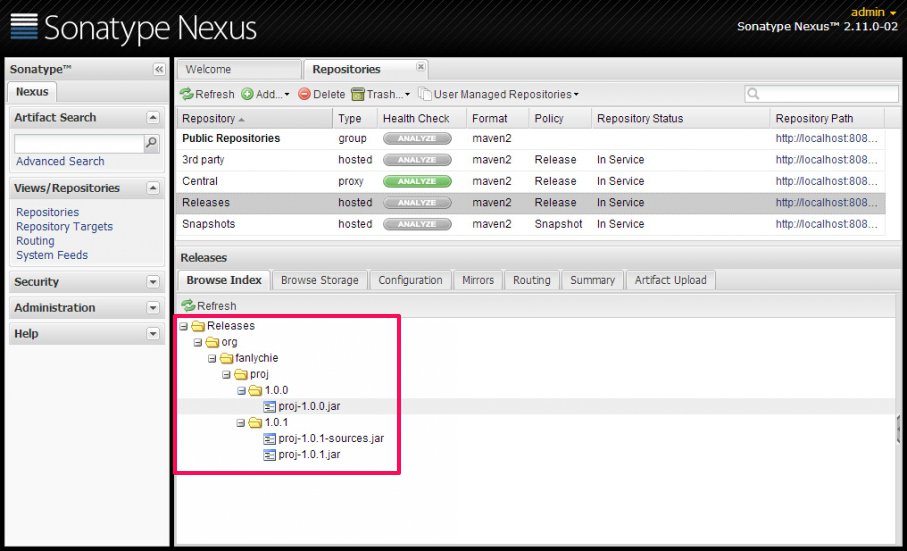
发布快照
快照用于区分稳定与不稳定的构件(发布的版本就是稳定的,快照版本是不稳定的)。构件的升级通常会带来许多的不稳定性,需要不断的修复,快照可以避免由于升级带来的不稳定性迫使的不停的升级版本号,最终造成版本号的泛滥的问题。快照允许重新发布,而不需要变更构件的版本号。
在 nexus 中找到如下的视图页面:
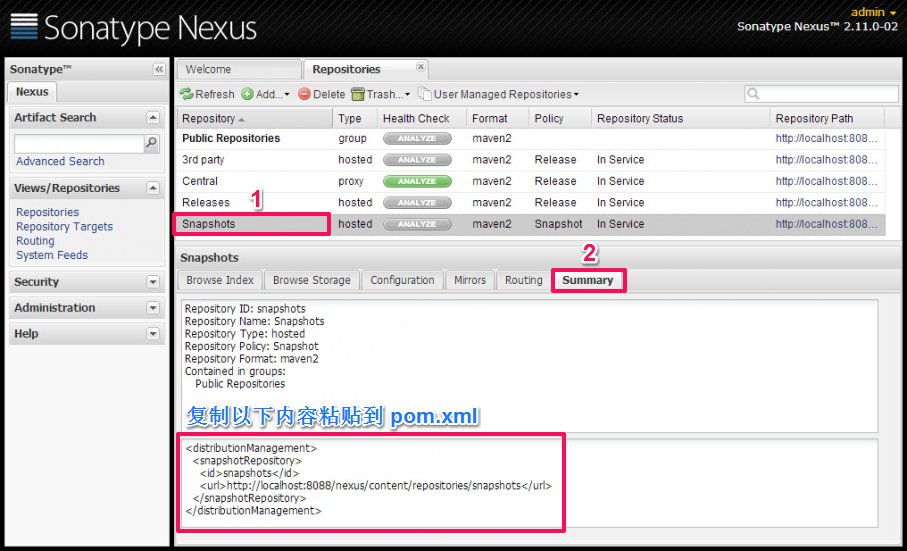
复制以上的配置,粘贴到你的 pom.xml 配置文件中:
<project xmlns="http://maven.apache.org/POM/4.0.0" xmlns:xsi="http://www.w3.org/2001/XMLSchema-instance"
xsi:schemaLocation="http://maven.apache.org/POM/4.0.0 http://maven.apache.org/xsd/maven-4.0.0.xsd">
<modelVersion>4.0.0</modelVersion>
<groupId>org.fanlychie</groupId>
<artifactId>proj</artifactId>
<version>2.0.0-SNAPSHOT</version>
<packaging>jar</packaging>
<name>proj</name>
<url>http://maven.apache.org</url>
<distributionManagement>
<repository>
<id>releases</id>
<url>http://localhost:8088/nexus/content/repositories/releases</url>
</repository>
<snapshotRepository>
<id>snapshots</id>
<url>http://localhost:8088/nexus/content/repositories/snapshots</url>
</snapshotRepository>
</distributionManagement>
<build>
<plugins>
<plugin>
<groupId>org.apache.maven.plugins</groupId>
<artifactId>maven-source-plugin</artifactId>
<version>2.4</version>
<executions>
<execution>
<id>attach-sources</id>
<phase>install</phase>
<goals>
<goal>jar-no-fork</goal>
</goals>
</execution>
</executions>
</plugin>
</plugins>
</build>
</project>
版本号含有 SNAPSHOT 的构件将发布到 Snapshots 仓库,否则,将发布到 Releases 仓库。执行发布命令:mvn deploy,结果如图: xsi:schemaLocation="http://maven.apache.org/POM/4.0.0 http://maven.apache.org/xsd/maven-4.0.0.xsd">
<modelVersion>4.0.0</modelVersion>
<groupId>org.fanlychie</groupId>
<artifactId>proj</artifactId>
<version>2.0.0-SNAPSHOT</version>
<packaging>jar</packaging>
<name>proj</name>
<url>http://maven.apache.org</url>
<distributionManagement>
<repository>
<id>releases</id>
<url>http://localhost:8088/nexus/content/repositories/releases</url>
</repository>
<snapshotRepository>
<id>snapshots</id>
<url>http://localhost:8088/nexus/content/repositories/snapshots</url>
</snapshotRepository>
</distributionManagement>
<build>
<plugins>
<plugin>
<groupId>org.apache.maven.plugins</groupId>
<artifactId>maven-source-plugin</artifactId>
<version>2.4</version>
<executions>
<execution>
<id>attach-sources</id>
<phase>install</phase>
<goals>
<goal>jar-no-fork</goal>
</goals>
</execution>
</executions>
</plugin>
</plugins>
</build>
</project>
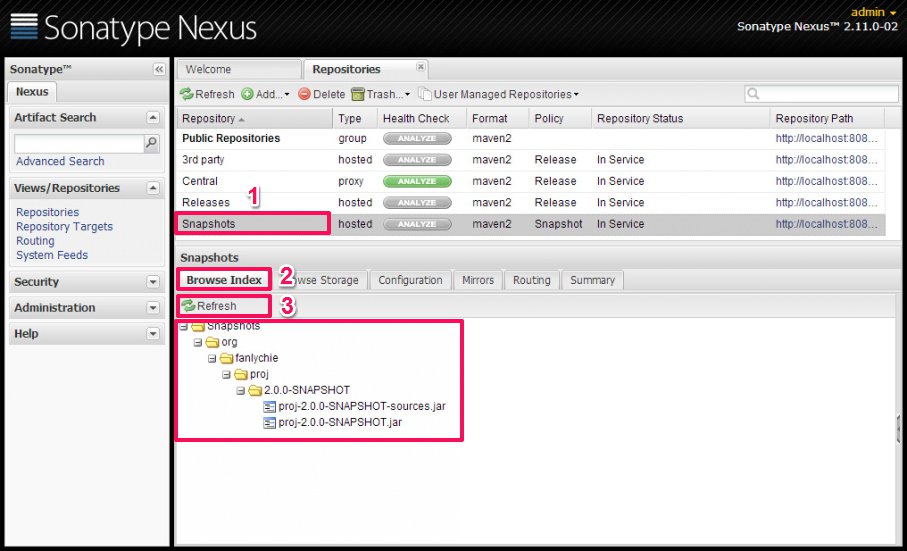
发布第三方构件
步骤见下图的标注:
命令行方式发布:
mvn deploy:deploy-file -DgroupId=自定义groupId -DartifactId=自定义artifactId -Dversion=版本号 -Dpackaging=jar
-Dfile=JAR文件的路径 -Durl=http://127.0.0.1:8088/nexus/content/repositories/thirdparty -DrepositoryId=thirdparty
-Dfile=JAR文件的路径 -Durl=http://127.0.0.1:8088/nexus/content/repositories/thirdparty -DrepositoryId=thirdparty
远程索引
在 nexus 中找到如下的视图页面: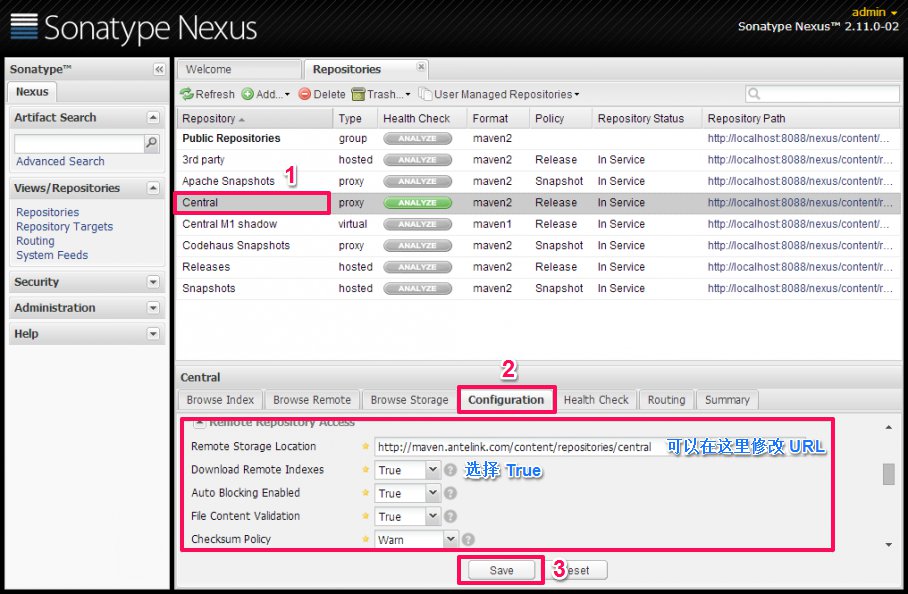
保存之后,在左侧面板中选择 Administration --> Scheduled Tasks,如下图:

可以看到这里有一个 Repair Repositories Index 任务,任务完成之后会自动从面板中移除,点击左上角的 Refresh 按钮来查看。任务完成
之后回到 Repositories 面板,选择 Central 仓库右键,选择 Update Index,再回到 Scheduled Tasks 面板,可以看到有一个 Update
Repositories Index 任务,这个任务花时较长,任务完成之后,回到 Repositories 面板,在 Browse Index 中可以看到从远程仓库下载回
来的索引文件,有了索引,即使 nexus 私服还没有你想要构件,你也可以搜索出你想要查找的构件。
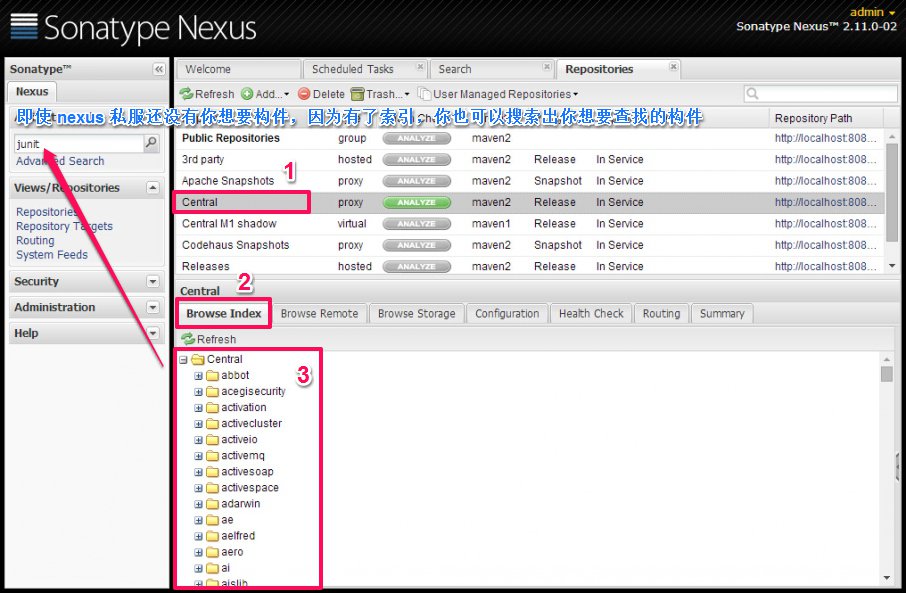
参考:https://www.cnblogs.com/exmyth/p/5693153.html







相关推荐
Linux Maven Maven私服Nexus安装文档主要涵盖了在CentOS操作系统上安装和配置Maven以及搭建Maven私有仓库Nexus的详细步骤。以下是整个过程的详细说明: 1. **安装Maven** - **确认安装源**:首先,你需要检查你的...
Maven Nexus 私服搭建 从零开始,资源下载、安装指导、开发配置说明
maven私服搭建-nexus的部署 Maven 私服是指在局域网或 Intranet 中搭建的 Maven 仓库,用于存储和管理项目依赖的 Jar 包。Nexus 是一个流行的 Maven 私服解决方案,提供了强大的仓库管理功能。 在本文中,我们将...
它在Maven、Gradle等构建工具中广泛使用,尤其对于企业级开发环境而言,搭建私有Maven仓库(即“私服”)至关重要,因为它能提高依赖下载速度,保护内部组件不被外部访问,以及统一管理版本。 "nexus-3.16.2-01-...
"手动搭建maven私服-安装配置nexus 3.4教程" 手动搭建maven私服是指使用nexus 3.4安装配置一个maven私服,实现公司或个人项目的构件管理。下面将详细介绍手动搭建maven私服的过程。 一、安装nexus 3.4 首先下载...
### Windows 下 Nexus 搭建 Maven 私服详解 #### 一、为什么使用 Nexus 在软件开发过程中,尤其是采用 Maven 构建管理的项目中,依赖管理是非常关键的一环。通常,开发人员需要从 Maven 中央仓库下载各种依赖库到...
本文将详细介绍如何使用最新的Nexus版本搭建和使用MAVEN私服,以及如何实现jar包依赖。 **1. Maven与Maven私服** Maven是Apache软件基金会开发的一款项目管理和集成工具,它通过POM(Project Object Model)文件来...
下载完成后,解压缩到指定的目录下,然后进入 nexus-2.1.2-bundle\nexus-2.1.2\bin\jsw 目录,根据操作系统类型选择文件夹,例如 windows-x86-32 文件夹。双击 console-nexus.bat 运行,输入 ...
### 在CentOS下使用Nexus搭建Maven私库的安装教程 #### 一、引言 随着企业级项目规模的不断扩大和技术栈的日益复杂,如何有效地管理项目中的依赖成为了一个重要的问题。Maven作为Java生态中最流行的构建工具之一,...
本教程将指导您在Linux环境下,利用Nexus 3.14和Maven 3.6.3快速搭建Maven私服。 首先,我们来看看所需的主要组件: 1. **Nexus 3.14**:这是Sonatype公司提供的开源仓库管理工具,它可以作为Maven私服,支持多种...
《全面解析:使用Nexus搭建Maven私服》 在软件开发过程中,Maven作为一个强大的构建工具,极大地简化了项目的管理。然而,随着项目的发展,依赖库的数量会不断增多,这时,本地Maven仓库可能无法满足需求,这时就...
4. 修改nexus-3.4.0-02目录下的/etc/nexus-default.properties文件,关注application-port、application-host和nexus-features等设置。 四、Nexus3的安装与管理 1. 在/usr/local目录下创建nexus文件夹,并解压Nexus...
在上图中,搭建私服后,所有的依赖从私服下载,私服会自动判定,若私服库里没有所需的资源,则私服会自动去远程中央仓库下载,若私服已包含所需资源,则可以通过内网提供给使用者,大大提高工作效率。 我们使用专门...
**Nexus Maven 私服搭建详解** 在软件开发过程中,Maven 是一款广泛使用的构建工具,它通过依赖管理简化了项目构建。然而,随着项目的增多,依赖库的规模也会不断增大,直接使用中央仓库可能会导致下载速度慢、网络...
本文将围绕“maven私服nexus-2.14.8-01-bundle.tar.gz”这一版本,详细解析其核心特性与应用场景。 Nexus 2.14.8-01是Sonatype公司发布的一个稳定版本,该版本包含了Nexus的核心组件和工作目录。其中,“sonatype-...
Maven私服Nexus搭建详细配置介绍,需要修改settings.xml、pom.xml等文件的参数
在 Maven 的 `~/.m2` 目录下编辑 `settings.xml` 文件,添加 Nexus 私服的代理配置: ```xml <id>nexus * <url>http://localhost:8081/repository/internal-releases/</url> ``` 同时,为了发布到私库,...
【 Maven 私服与 Nexus 的理解】 Maven 是一个广泛使用的 Java 项目管理和综合工具...使用 7-Zip 解压缩 `maven_私服_nexus-3.20.1-01-win64.zip.7z` 文件后,按照上述步骤配置和使用 Nexus,为你的开发工作带来便利。
### Maven使用及Nexus搭建Maven私服的知识点详解 #### Maven简介与作用 Maven是Apache软件基金会组织下的一个开源项目,它是一个项目管理和综合工具,主要用于Java项目的构建、依赖管理和项目信息管理。通过Maven...
**Nexus搭建私服** Nexus是Sonatype公司提供的一个强大的Maven仓库管理器,它可以作为企业内部的私有仓库,用于托管内部项目构件,同时也可以作为代理,缓存远程仓库(包括中央仓库)的构件,减少网络延迟。搭建...